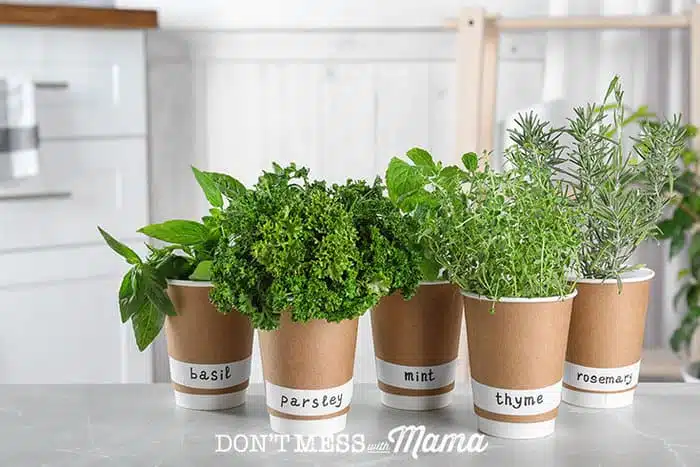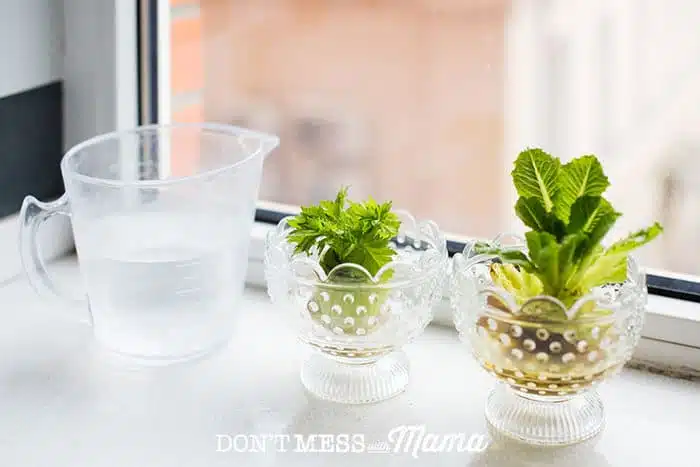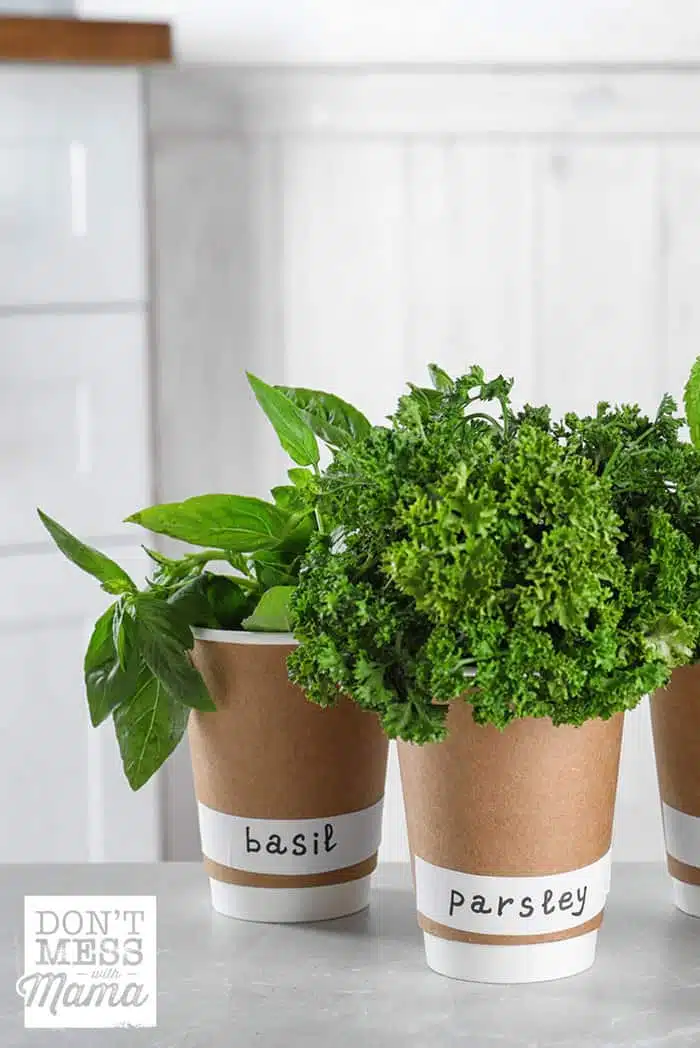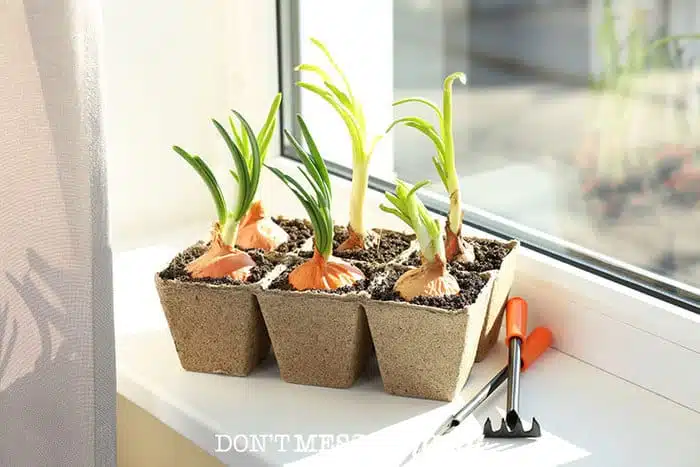35 Foods You Can Grow Indoors
Want to grow your own food indoors? Check out this beginner’s guide to grow your own fruit, herbs and vegetables indoors. You’ll be able to easily grow 35 foods from seeds or kitchen scraps all year long.
This post contains affiliate links. Please read my affiliate disclosure.

You don’t have to have a green thumb to start your own kitchen garden. You can grow your own herbs, vegetables, leafy greens and even fruit indoors with just a few simple tips. This is perfect for beginners or anyone who wants to grow food indoors, even in small spaces or apartments.
How to Grow Food Indoors Guide
Many of the herbs, fruit and vegetables you know and love can be grown inside. If you have enough space for one stack of shelves then you have enough space to grow food. I’ve compiled a list of vegetables you can grow indoors no matter where you live and no matter what season it is. I’ve also included some herbs and fruit that grow well indoors too. But before we take a look at that list we should talk about the things you are going to need for your new indoor garden.
1. Start Simple
Don’t over complicate it or be overly ambitious. Trying to keep up with 50 different plants is going to be a nightmare, and in the end many of them will die. Instead, start with just a few, like 3-5 herbs (or an indoor garden starter) easy vegetables you can grow. Dedicate a small area in your kitchen for your garden, and limit your garden to that space until you have a handle on things. While some kitchen gardening vegetables work great in the beginning, you may need to repot them later on.
2. Find a Spot to Garden
Ideally, this spot would be next to a window that gets a lot of sun all day long. But, that isn’t always possible and that’s ok. You can still grow food in just about every room in your house. The only ones I don’t recommend are unfinished cellars, attics, and the bathroom.
You can garden in any room in your house because there is no need to rely on the sun to give its life- sustaining rays to your plants when you can use grow lights instead. You will need at least one grow light for every shelf that you have plants growing on.
3. Go Vertical if You’re Short on Space
Small kitchens can still have a kitchen garden. Add wall planters or hanging vertical planters to maximize space, and it serves as beautiful home decor as well. Be creative with your space, and don’t be afraid to think outside the box.
4. Opt for Organic Soil and Compost
Consider organic soil and compost. Both will be a little bit more expensive than other options, but it is the best suited for growing indoors. After a few weeks, the nutrients in that soil will run out and you will have to start feeding your plants fertilizer. For this, I recommend a liquid organic fertilizer. Many of these will be made using fish but you can also buy seaweed-based to cut back on smell and go vegan.
You can even keep your food waste and compost it. Much of the food we throw away would make great compost for our gardens. You don’t need much if you are only using a few simple planters in your kitchen, but composting can help you build fertile soil. Keep a small compost bin in your kitchen for table scraps and add them to your kitchen garden.
5. Source with Seeds and Kitchen Scraps
There are a couple of options on how to source your food. You can buy seed packets or even reuse seeds from food you already have. It can take longer to grow as the seed needs to germinate, but it’s a great option if you don’t have a food source available. But if you do have food scraps, reuse them. They’re an excellent source to regrow your favorite produce.
How to Grow Food with Seeds
When it comes to starting seeds you can do it in just about anything, including the cardboard rolls from toilet paper. But, black plastic seed starting trays are an excellent idea if you don’t mind spending a little bit of money on them. The black will absorb more heat and for many plants, you will need that heat to help get the seeds started.
If you’re going to start your seeds in a room that is always cold or on the cooler side then you should consider getting heating pads for your seeds. When the plants begin to grow you will want to transfer them into pots with holes in the bottom. If they don’t have holes you are risking root rot, which is when the root of the plant decays, or mold.
How to Grow Food from Kitchen Scraps
Kitchen scraps can be used to make a variety of fresh garden produce for you. Leafy greens, and root and bulb vegetables, in particular, are easy to reuse. Just save the white root end and put in a glass of water to grow new sprouts. Then transfer to a potted container.

6. Get the Right Containers
Once your seedlings or kitchen scraps start to grow, you can transfer them to a container. Be sure the container has holes in the bottom for proper drainage. You can recycle a bucket, yogurt tubs, plastic containers, buckets, etc. Just be sure to drill holes in the bottom.
35 Foods You Can Grow Indoors
Herbs, leafy greens and green onions are great options to start with. You can start with seed packets or even your own kitchen scraps (which can actually cut down on the time to harvest).
Leafy Greens
You can get seed packets for each individual plant or even a seed packet of mixed greens. On average, they can take 30-60 days to mature to the point where you can cut off the leaves to eat.
A faster way to grow leafy green is to regrow them from kitchen scraps. Save the white root end and place in a small glass bowl with a little water. The green leafy parts will grow and you can use what you need. Replace the water every few days. You’ll see regrowth in about 14 days and can start eating the leaves in 21-30 days.
- Arugula
- Bok Choy
- Rainbow Chard
- Kale
- Lettuce
- Mustard Greens
- Spinach

Herbs
Generally, herbs from seeds take about 60-90 days to grow to full maturity. You can regrow from kitchen scraps, in particular if you have the roots. Rosemary can actually be regrown from clippings. Just place in a glass jar with a little water. Replace the water every few days. Within a week or so, you’ll see new growth. Transfer to a pot or garden.
- Basil
- Cilantro
- Dill
- Mint
- Oregano
- Parsley
- Rosemary
- Sage
- Thyme

Fruit
You can grow some fruit like citrus indoors and they don’t have to take up a lot of space. Since it’s harder to grow a citrus from a seed indoors, get a citrus tree that’s about 2-3 years old. Put it in a spot that gets a lot of indoor sunlight.
- Meyer Lemons
- Mandarin Oranges
Root and Bulb Vegetables
For all I find it easiest to save the root end (or a single clove for garlic) and put in a small glass bowl or glass jar. Replace the water every few days. New shoots will grow. Then transfer to a container with soil to grow. Generally, you’ll see sprouts growing within a week and some (like green onions) fully mature in about 10-14 days or about 30 days for carrots and ginger. You can start root vegetables from seeds, but it can take 70-120 days or longer to get to full maturity.
For potatoes, find one with eyes growing on it. Cut into pieces about 2-3 inches wide – each piece should have 2-3 eyes on it. Let the pieces dry out for a few days. Plant potato pieces about 5-6 inches deep in pot or garden. It may take 45-70 days to reach maturity.
Beets, carrots, and potatoes need large, deep containers so they have room to grow. So just keep that in mind. You can get these potato bags with flaps so you can see them growing beneath the soil.
- Beets
- Carrots
- Celery
- Ginger
- Green Onions
- Onions
- Potatoes
- Shallots
- Radishes

Other Vegetables
There are more vegetables you can grow at home but for beginners this is an easy list to start with. Generally, peppers, peas and tomatoes can grow in small spaces from seed to full maturity in about 45-60 days.
Keep in mind that tomatoes are in the nightshade family of vegetables and the leaves and stems of the plant can be toxic to pets, like cats and small dogs. It’s generally not fatal but can be uncomfortable so you might want to put it out of reach.
- Bell Peppers
- English Peas
- Hot Peppers
- Tomatoes (cherry and mini tomatoes)
Want Healthy Recipes for Your Family?
Check out my new book, Gluten-Free, Real Food Recipes for Kids. I wrote this book with YOU in mind. Parents who want to provide kids with wholesome meals without artificial colors, preservatives and other additives. All the recipes are gluten-free – with many options for grain free or Paleo, dairy free, egg free and vegetarian.
What’s Included In This Book
It’s filled with 130+ pages of content and recipes, including:
- Real food nutrition 101
- Detailed information on how to properly soak and sprout nuts, beans, grains and seeds
- A guide on how to spot chemical additives and what to avoid
- Kitchen essentials and cooking tools
- Tips on how to get kids to become better eaters and help in the kitchen
- 70+ gluten-free recipes – such as snacks and appetizers, beverages, condiments and dressings, main meals, desserts and more
Posts You Might Like
- 15 Foods to Always Stock in Your Kitchen
- 10 DIY Cleaning Recipes
- Speed Cleaning Your Kitchen in 30 Minutes
Did you try these tips? Comment below to let me know how it went. You can also FOLLOW ME on Facebook, Instagram and Pinterest.
Photo credit: Bigstockphoto.com / New Africa, Elena El, manera, Yastremska

